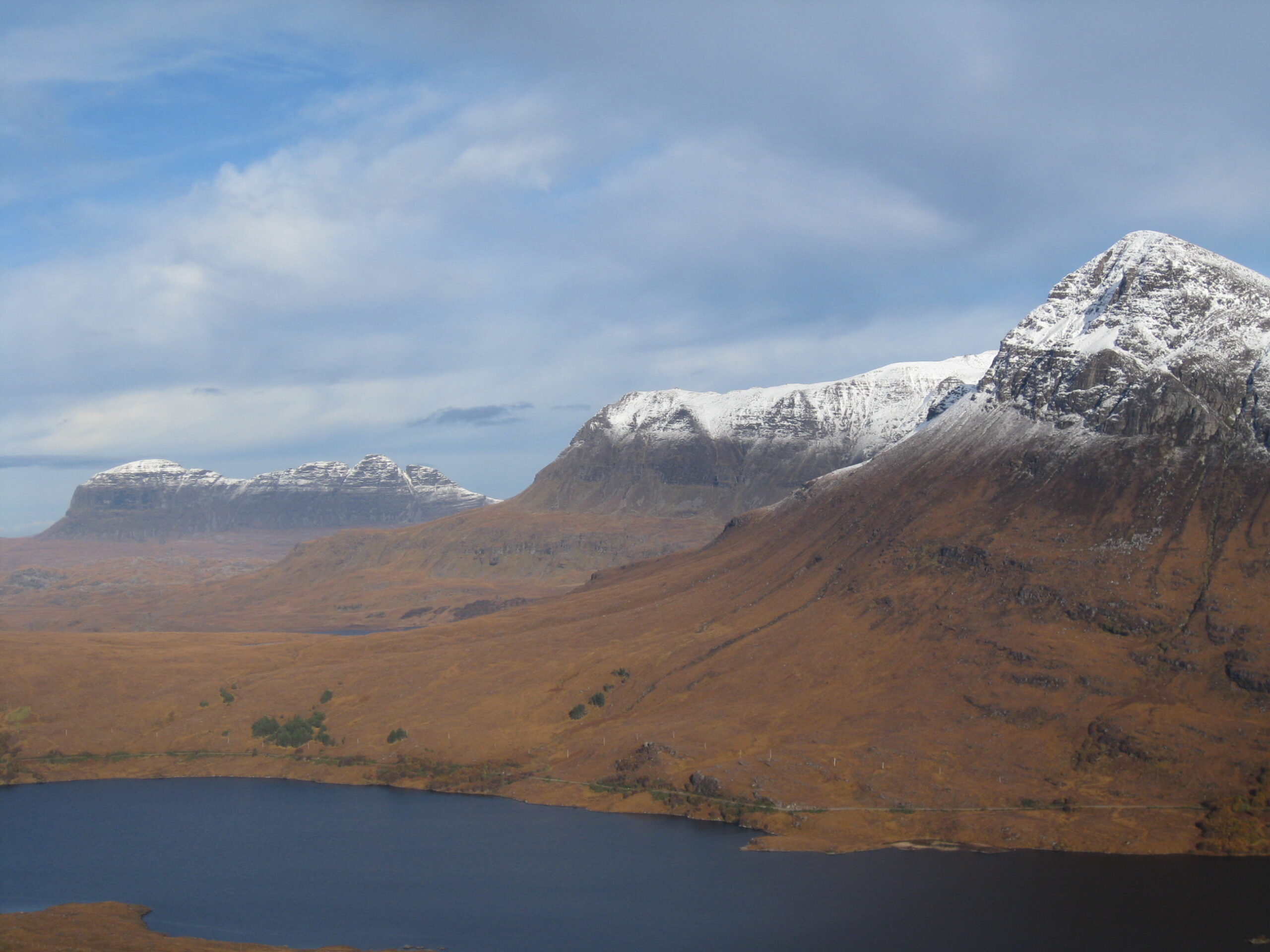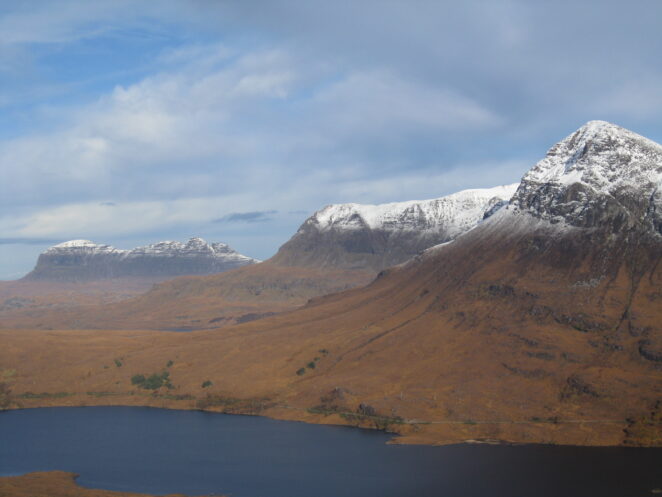Case-study /
Coigach-Assynt Living Landscape


Photograph by Viv Halcrow
The Coigach-Assynt Living Landscape (CALL) is one of the largest landscape restoration projects in Europe, aiming to benefit the land, the people and the local economy in the north west of Scotland. Working with landowners and local people, this partnership project aims to restore the health of the whole ecosystem by improving and reconnecting habitats (especially native woodlands and peatlands) and creating rural employment and volunteering opportunities.
Project background
In the north-west highlands of Scotland there has been a decline in biodiversity, mainly caused by a reduction in habitat quality through overgrazing and burning. Fragmentation of native woodlands has also contributed to this decline. Habitat restoration is the process of assisting the recovery of an ecosystem that has been degraded, damaged, or destroyed. Habitat improvement involves the maintenance and enhancement of the food, water, cover etc components necessary in an existing habitat and removal of pressures, such as pollution, to improve the quality of the habitat. Restoration, improvement and linking of habitats across land-ownership boundaries will help to counter this negative effect on biodiversity, which is under further pressure from the increasing impacts of climate change. Such ecosystem scale-restoration also improves our understanding of the impacts of climate change at a landscape scale and how to ensure wider resilience.
Climate change is likely to become one of the most significant drivers of biodiversity loss by the end of the century. Changes in climate can have significant impacts on biodiversity and ecosystems, including causing changes in species distributions and impacting on climate space, population sizes, the timing of reproduction or migration events, changes in community ecology, impacts of extreme weather events, and an increase in the frequency of pest and disease outbreaks. Climate change is projected to exacerbate the loss of biodiversity and increase the risk of extinction for many species, especially those already at risk due to factors such as low population numbers, restricted or patchy habitats, and limited climatic ranges.
Habitat fragmentation will make migration to new climate space impossible for most species, as they try to track their climate space. Biological communities may become increasingly dominated by certain types of animals and plants; mobile generalists may continue to prosper, whereas specialists are likely to continue to decline.
Some of the main goals of this project include:
- Conserve or restore the built and natural features that create the historic landscape character
- Increase community participation in local heritage
- Increase access to and learning about the landscape area and its heritage
- Increase training opportunities in local heritage skills
What’s been done so far?
Scottish Wildlife Trust data team has developed, with input from landowning partners, a Woodland Opportunities Map. This GIS based system uses all available data and shows where woodland could be expected to grow. The map will be further refined through community consultation to ensure local people are happy with areas identified for woodland expansion. Existing woodland remnants will be linked by a combination of planting and regeneration. Existing forest plans are being modified to fit with this. Landowning partners and crofting townships will carry out their plans using the Landscape Partnership funds (assuming this bid is successful) and further funding through eg SRDP. CALL has set up an on-site tree nursery to provide planting stock of a wide range of species, all from locally-collected seed.
Local people are being offered the chance to input to the development of Landscape Partnership work through a series of information events. More ‘people-centred’ projects such as access and interpretation development will need input from the community. As well as offering jobs, CALL will offer training in a wide range of skills, from habitat monitoring to butchery to lime-mortaring, and there will be a variety of ways in which people can be involved on a volunteer basis. Currently volunteering is restricted to the tree nursery but there will soon be many more opportunities. In addition, staff will organise outreach events to inspire people about heritage, eg an upcoming seashore day and open day at the tree nursery.
Links with habitat management projects in Romania have been strengthened by an exchange visit for 4 people from CALL plus reps from Knoydart Forest Trust and Community Woodlands Association. Their insights will be used to develop community-based actions in the CALL area. Visit three villages in May 2014 in the Apuseni mountains where CALL will learn the value of truly sustainable land management and community involvement. Aim to then deliver community events building on lessons learnt in Romania, to encourage people to get involved in local land management and to develop strong communities for the future.
The ambitious project covers an area of over 60 000 hectares and has already carried out several pieces of work:
- Re-establishment of large areas of native woodland is under way. This has led to the establishment of a native tree nursery to provide saplings for local replanting. This also underpins one high-quality rural job (Tree Nursery Manager) and the nursery acts as a focus for community events.
- 480ha of blanket bog has been restored through damming of drainage ditches.
- Monitoring indicators, for socio-economic as well as ecological factors, are in the process of being set up.
What’s next?
A wide-ranging aspirational list of projects requires a substantial investment – CALL applied to the Heritage Lottery Fund as a Landscape Partnership for £3million. CALL has increased its scope to do this and involved five more partners. In addition to this CALL has employed three more staff to carry out development work leading to the Stage 2 bid submission due in May 2015.
Early goals include: • Continuing to develop the tree nursery and market the young trees direct from the nursery and at community events.
• Working harder on community engagement: a programme of drop-in information events is planned for late summer 2014.
• Involving more landowners in the work of CALL.
• Rolling-out the Woodland Opportunities Map to more landowners and the wider public for comment
• Delivering practical community events building on lessons learnt on the recent fact-finding visit to Romania, and sourcing funding to host a group from Romania in spring 2015
Policy context
One of the main lessons learnt so far in the project is that securing funding is very time-consuming process and requires particular skills. If policy makers increased the ease with which applications could be made this would help greatly.
Ensuring the interest and support of the wider community is also essential for CALL to succeed in the long term.
The communities of Coigach and Assynt are working together to achieve a truly living landscape through improved understanding of their environment and the impacts of climate change; shared active management providing a diverse range of connected and resilient habitats; creation of local employment and training opportunities, and building on the communities’ strong cultural heritage linked to the land. Working with landowners and local people, CALL aims to restore the health of the whole ecosystem by reconnecting fragmented forests, restoring peatland and creating nature-based employment and volunteering opportunities, all of which will help CALL to adapt to future climate change impacts.
